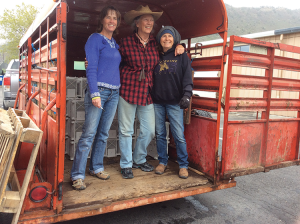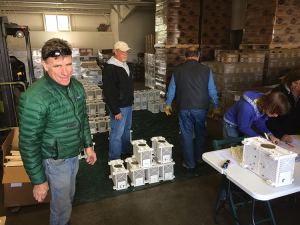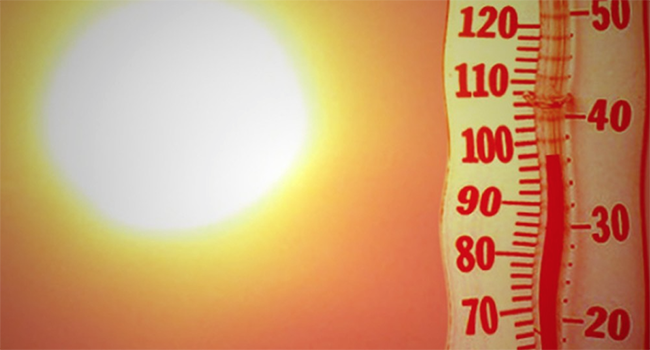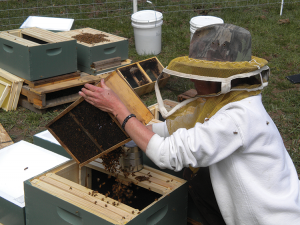By: Tina Sebestyen
Sometimes tragedy strikes beekeepers and bee clubs.

Bee Wranglers from left, Tina Sebestyen, Carrie Jenkinson, and Carol Tyrrell with a trailer load of bees. Ed Young photo.
One fellow I know had an emergency that demanded immediate attention just as he was arriving with his clubs’ packages of bees from California one year. He made it home with the bees in the trailer just fine, dropped the sides, and left the bees on the trailer in the shade for just a short time. When he returned, all the bees were dead, every package had over-heated. I heard another horror story about a group whose bees all drowned because the change in altitude as they drove over the mountain passes pushed the sugar syrup out, covering the bees. Transporting bees is not for the faint of heart, but an important service provided by courageous people for your bee club.
We may not save the world with jello, but it might save your bees if you cannot avoid driving over mountain passes. Some suppliers are putting a jello-like substance in for bee food instead of sugar water. This could be the answer for you. The best solution for our bee club was to find a supplier located where driving mountain passes is not required of us to get home with our bees. Another awful thing that can happen when altitude removes the bee food is if the recipients don’t hive the bees right away, and they starve waiting for a nice day. Here in Southwestern Colorado, it has snowed on bee delivery day for the past five years or so. We have learned that we can hive bees just fine in cold or snowy weather, though we sometimes wait a day or two if the weather is going to improve and we are sure there is plenty of bee food in with that package. You can feel the weight of the can if you pry it up a tiny bit with your hive tool, and determine if the can is empty, full, or somewhere in between. If the weather really dictates waiting to install the bees, it is possible to feed them by lightly spritzing the outside of the package with one-to-one sugar water. Do not soak the bees, or you bring tragedy home with you.
The biggest threat to packages of bees in transit is heat. Bees overheat very quickly. We regularly bring in 190 packages of bees now, and that is a very tall stack of bee packages in a four horse trailer. The taller and more densely the bees are packed in the trailer, the hotter they will be. If you are transporting more than 200 packages, it would be wise not to pack them tighter or taller, but to find a longer trailer. A horse trailer usually has sides that open up high, so that wind does not blow right on the bees, but draws hot air off the top, and a breeze circulates through the packages as long as the trailer is moving. Some horse trailers have sides open over half-way down. This is too much wind, and the sides need to be closed up about three quarters of the way up with plywood, or even duct tape and cardboard. Box trailers have no openings and are too hot.

Four Corners Beekeepers Assoc. members matching bees and beekeepers (we offer different races of bees; Russian, Italian, and Carniolan). Ed Young photo.
We hang a remote temperature sensor in the middle of the stack of bee packages, with the receiver in the cab. This has the interesting effect of keeping our blood pressure down, since rather than just imagining what may be happening in the bees, now we can see. If the temperature begins to rise too much, it is time to take action. A pump type weed sprayer that has never been used for anything but bees and never had anything in it but water is the perfect answer. Just mist the bees and the air over and around them, do not soak them. This cools them down nicely and gives them a little drink, too. Be sure to check your sprayer before you leave home. Discovering a broken sprayer or bad gasket when the bees are already hot is definitely stress inducing.
We also hang old fashioned mercury thermometers by strings at different places and heights in the stacks as a no-fail back-up, with one right on top. It is also possible to tell if the bees are hot by their behavior. If the bees are hot, they run in the cages rather than clustering nicely around the queen. One of the rules of bee transport is Never Stop. You cannot afford to stop for a meal, even if it is your favorite place. The bees start getting hotter the minute the air isn’t circulating through them from the motion of the vehicle. Brief stops for gas can be fun, though. There are always bees on the outsides of packages, and lots of packages means lots and lots of flying bees during a stop. While one person fills the tank, the other mists the bees, and you both enjoy super-hero status with the lookers-on, who think you are amazingly brave to stand there with all those bees flying around your head. Little do they know. Try not to smirk.
Living in the high desert has its challenges, and the weather is one of them. Some years we have transported the bees through the Utah desert at 80°, and we are panic-stricken about them over-heating. Lately, as I said, it is usually cool weather, and we thankfully drive through 65° temps. And a few years, it has been snowing as we drove in temps of under 40°, and we worry about the cold. As always, the bees can handle cold pretty well, but if temperatures of 40 or below are expected, it would be good to have a way to decrease the amount of wind going through the bees and the trailer. A tarp is a good thing to have along in case you need to cover the bees or the air vents in the front of the trailer.
Cold weather is the reason we use a horse trailer exclusively. Horse trailers have springs to cushion the ride, making it less bumpy. In a plain old behind-the-truck trailer, there are no springs. In cold weather, the bumps in the road knock the bees out of the cluster, they are paralyzed by the cold and cannot get back into the cluster, and they can die. Even if it is fine weather, constantly being bumped out of the cluster is very stressful to the bees. They are stressed already, and we need to minimize stress as much as possible. We beekeepers love the smell of the bees in the hive, that nice flowery, lemony smell. When the bees are stressed, their scent is sharper and more lemony. Bee packages always smell strong and sharp.
Another rule of bee transport is Get the Bees Out of the Trailer Immediately upon arriving. Since it has been snowing on bee day the past few years, we have found a warehouse that will allow us to use their space to stack the bees inside while we match bees and beekeepers. Breweries often have a space like this, and it is nice for our beeks to sit inside, talk bees with one another, and have a nice drink while they wait for us to arrive. It is possible to pass out the bees in an empty parking lot, but before you do anything else, get the bees out of the trailer. Stack them on the shady side of the trailer, and work from there.
We bring several huge tarps to cover the floor, since bee packages are inevitably sticky. We bring a fan and extension cord, in case the bees get hot and are running in the cages. There is nothing more stressful to beekeepers than stressed and unhappy bees. Some suppliers provide extra queens in case some of the package queens have died. We keep them in the truck cab as much for ourselves as for them while we drive. It is very pleasant to watch the queens and attendants lick up the occasional drop of water we place on the screen as we move them to shady spots on the seat. These queens can be kept in the cages for a week, if water is given two or three times a day. A drop of honey is welcome, as long as you know it came from healthy bees. I think they do better with a bit of previously frozen bee bread pushed into the screen, too. I’ve had them last two weeks, but never wanted to risk a queen’s life to see if they could be kept longer. Be careful of the queen’s tiny feet when applying water, honey, or bee bread to the screen. A cool, dark place like a windowless bathroom is the perfect temporary home for these girls while you enjoy their company.
The last piece of successful bee delivery is insuring their survival by educating recipients about how to install their bees properly. Along with the bee packages, we provide a list of instructions to try to help people avoid those “exciting” moments in hiving, and to help them enjoy their first date with their girls.
I have read that it is important to make sure there is not more than an inch of dead bees on the bottom of the package. My hope is that with these tips on transporting bees, you will have the same success we have had, rarely more than five or six dead bees in the package, and bees calm enough to settle into their new homes quickly and peacefully.
Tina has been hooked on beekeeping since 2007 in top bar, langstroth, and more recently, the long langstroth hive. She is founder of the Four Corners Beekeepers Assoc, and is vice president of the Colorado State Beekeepers Assoc. She would like to thank her many mentors who take the time to listen and advise.








